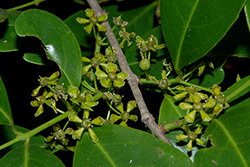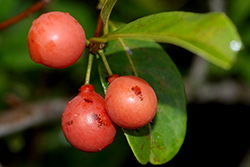e-Flora of Thailand
Volume 10 > Part 2 > Year 2010 > Page 189 > Celastraceae > Salacia
1. Salacia chinensis L.wfo-0001065503
Mant. 2: 293. 1767; Ding Hou in Steenis, Fl. Males. ser. 1, 6: 419, fig. 37. 1964; P.H.Hô, Câyco Viêtnam (Ill. Fl. Vietnam) II, 1: 194, fig. 4172. 1992; J.S.Ma, Z.X.Zhang, Q.R.Liu, H.Peng & Funston in Z.Y.Wu, P.H.Raven & D.Y.Hong, Fl. China 11: 489. 2008. Plate XXVIII: 1.
Accepted Name : This is currently accepted.
Synonyms & Citations :
Description : Lianas, straggling or scandent shrubs, rarely shrubs or small trees, up to 8 m tall. Leaves subcoriaceous, rather discolorous, ovate, broad-elliptic, obovate, rarely suborbiculate, 4–17 by 1.7–9.5 cm, base cuneate, apex acute, short-acuminate to acuminate, sometimes obtuse, margin entire or slightly crenulate, nerves 4–10 per side, petiole 10–15 mm long. Flowers yellowish or yellowish green to green, few to many in fascicles or on axillary, bracteate tubercles, sometimes ramifiorous; pedicels 5–10 mm long. Calyx lobes less than 1 mm long, obtuse or rounded, slightly erose. Petals broad-elliptic, -ovate, obovate or suborbiculate, 3—4 by 2.5–4 mm, obtuse, the marginal part yellowish when dry. Disk round cushion-like, 1.5–2 mm in diam., usually rather thick, often papillate towards the margin. Stamens 3, very short, ca 1.5 mm long. Ovary 3-loculed; ovules 2 in each locule. Fruits globose, sometimes broad-ellipsoid, 1.3–2 cm in diam., red or orange-red, usually 1-seeded. Seeds globose, 1–1.5 cm in diam.
Thailand : NORTHERN: Lampang (Maharat, Mae Chang, Mae Peng, Palat, Thung Kuien, Wang Liang), Phrae; NORTH-EASTERN: Loei (Si Than), Sakon Nakhon (Phu Phan), Nakhon Phanom (Tha Uthen – type of Salacia socia: Kerr 8437); EASTERN: Chaiyaphum (Ban Nam Phrom, Kon San), Si Sa Ket (Kantharalak); SOUTH-WESTERN: Uthai Thani (Huai Kha Khaeng), Kanchanaburi (Khao Ngai Yai), Phetchaburi (Ban Cha-Am), Prachuap Khiri Khan (Bang Saphan, Hua Hin, Kan Kradai); CENTRAL: Lop Buri (Dan Khun Thot), Ang Thong, Nakhon Nayok (Khao Yai NP, Muang dist.); SOUTH-EASTERN: Sa Kaeo (Kao Sisiat), Chon Buri (Nong Kao, Si Racha), Trat; PENINSULAR: Chumphon (Kon Son), Ranong, Surat Thani (Ban Na San, Ko Pha-ngan, Nong Wai), Trang (Khao Phap Pha, Thung Khai, Yan Ta Khao), Phathalung (Tha Mot), Satun, Songkhla, Narathiwat.
Distribution : Widely distributed but scattered in India, Sri Lanka, Myanmar, China (type), Cambodia, Laos, Vietnam, throughout Malesia, to the Caroline Islands, Australia, New Britain, Solomon Islands, and as far as Fiji.
Ecology : Lowland evergreen, seasonal, deciduous forests, limestone hills, secondary forests on sandstone, freshwater swamp forests, from sea level to 1,550 m alt. Flowering: January April, October, December; fruiting: January–May, September, October, December.
Vernacular : Kamphaeng chet chan (กำแพงเจ็ดชั้น)(Phuket); kua mae nam nong (ขัวแม่น้ำนอง)(Lampang); lum nok (หลุมนก)(Phuket, Surat Thani); sam chan (สามชั้น)(Loei); ta kai (ตาไก้)(Nakhon Ratchasima).



